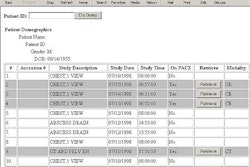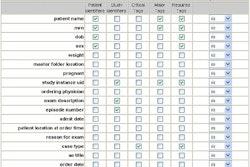PACS can solve many problems, but don't expect the technology to be a panacea, said PACS pioneer Dr. Steven Horii of the University of Pennsylvania Medical Center in Philadelphia.
"I'm not going to discourage anybody from doing PACS," he said. "We've done (PACS), and what I'm trying to get across is what we've learned along the way. We're now in our fourth generation of PACS, and we've learned a lot and made a lot of mistakes."
Horii discussed PACS caveats and considerations during a presentation at "PACS 2003: Integrating the Healthcare Enterprise," sponsored by the University of Rochester School of Medicine and Dentistry, in San Antonio.
RFP mistakes
An incomplete functional specification can cause problems during the request for proposal (RFP) process, Horii said.
"Be sure you get information from the end users of your systems, not just supervisors and administrators," he said.
It is worthwhile to have an independent expert help develop or review the functional specification, Horii said. One should also avoid assigning critical functions to a single individual, as vacations can wreak havoc. And one should not assume that personnel do only what's in their job descriptions.
"We discovered in our department that, inexplicably, some studies were getting done a lot quicker than others," he said. "We found out that (some of) the techs were bypassing our whole scheduling process."
Prospective purchasers need to ask vendors how the PACS will handle all radiology department functions and interaction with other departments, he said.
"If you have no answer for a particular task, you are going to have a problem with the PACS transition," Horii said. "Some vendors may say to you, 'that's an implementation issue, we'll figure that out when we install your system.' That's not a good enough answer."
Orthopedic and other surgeons will demand film, and it's not necessarily an unreasonable request. Not many appliance (device) templates exist in an electronic form that they can use, Horii said.
"Some of the workstation vendors have these applications, but they tend to be for a small catalog of appliances because the companies, quite understandably, are unwilling to share their drawings," he said. "This is proprietary, there are a lot of intellectual property issues with this stuff, and they're not going to want to just give these drawings away. I can understand their reluctance, but if we're going to transition away from film, this is one of the things that we have to be able to fix for the orthopedic surgeons."
A drawback to the use of PACS in surgical environments is that there aren't a lot of workstations located in operating rooms, he said.
Excessively complex radiologist workstations with "user-hostile" interfaces remain a cause of concern with PACS, Horii said. Workstations require too many steps to perform common tasks, and icon proliferation can frustrate radiologists.
Technologist workload
PACS can also bring an increased workload for technologists, if some tasks are not automated using Integrating the Healthcare Enterprise (IHE)-type features, Horii said. Technologists often perform PACS data entry; in film-based operations, front-desk personnel frequently handle that duty.
Having to move between the RIS and PACS can add to a facility’s workload, and correcting common errors can be very time consuming, he said. Image acquisition and workflow in a PACS environment is an important consideration, Horii said.
"If a right/left marker is left off (a computed radiography exam), how many steps and how long does it take for a technologist to solve this problem?" Horii said. "If the name on an exam is incorrect, how many steps and how long does it take to fix this? If not the technologist, who can fix this?"
The choice of storage systems is complicated by a number of factors, including media obsolescence. Horii recommends considering an all-hard-disk RAID (or network-attached storage [NAS] or storage-area network [SAN]) model.
"Storage costs are falling fast enough, with a capacity doubling time of about 18 months, to consider the 'just-in-time' archive plan," Horii said.
Architectural/engineering planning
Poor facility layout can lead to several more problems, including the loss of any ergonomic benefits to equipment.
"A well-designed piece of equipment may be made uncomfortable or impossible to use if put in an inappropriate space," he said.
Common design pitfalls include thinking that architects and designers know as much about the work environment as the radiologists who work in it. In fact, the designer may think of radiology as very similar to office work on video display terminals (VDTs), Horii said. If your architect has this mindset, find somebody who understands your work environment or make sure he/she gets a consulting architect who does.
Direct capture and integrated systems can reduce technologist workload, but these benefits can be lost if the facility layout is poor, Horii said.
"A walk down the hall to use a workstation or an extra 100 feet for patient transport can contribute to inefficiency," he said.
By Erik L. RidleyAuntMinnie.com staff writer
May 22, 2003
Related Reading
Small investments in imaging ergonomics yield major gains, May 21, 2003
Separating HIPAA facts from fiction, May 12, 2003
IHE pursues user adoption, product development, IT expansion, May 12, 2003
Web-based integration of PACS and RIS systems improves workflow, patient care, May 12, 2003
PACS archive techniques continue to evolve, March 18, 2003
Copyright © 2003 AuntMinnie.com




















